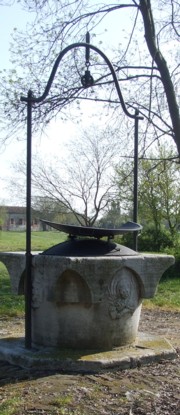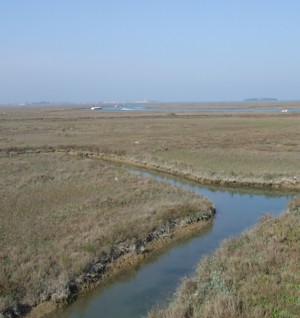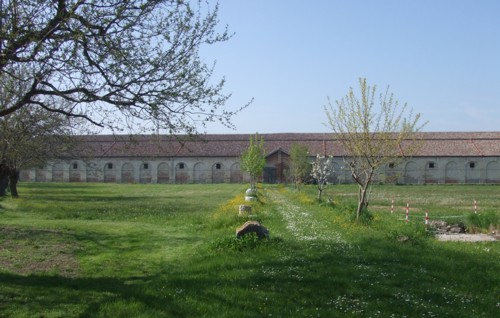The Isola del Lazzaretto Nuovo (or Novo) is a small island in the Venetian lagoon, a short boat-trip away from Venice. In the fifteenth century it became Venice’s second quarantine island. Today you can tour the buildings and ruins remaining from this era and from later Napoleonic fortifications.
Touring Lazzaretto Nuovo
For many years Lazzaretto Nuovo has been looked after by a voluntary archaeological group, which provides guided tours at weekends or by request.
Note that you can only visit the island at these times or by other prior arrangement:Tours take place between April and October, and only on Saturdays and Sundays, at 9:45am (take the 9:25am ferry from Fondamente Nove) and 4:30pm (the 4:10 ferry). The tour of the island is free, but you have the opportunity to make a voluntary donation afterwards. The latest times and contact details for visiting the island can be found on the official website, which is in English (see links panel).
The island tour takes about an hour and twenty minutes, and is generally conducted in Italian. If you want to organise a tour in English, try ringing ahead. Otherwise, if you don’t understand Italian, read the informative website beforehand and be prepared to tag along patiently. Wear practical shoes as you’ll be walking over grassy surfaces.
Travel
You will need to take the number 13 ferry which runs from Venice’s Fondamenta Nove stop to the island of Sant’ Erasmo. Ask to get off at Lazzaretto Nuovo, as the boat only stops there by request. On your return journey, you will find two buttons connected to light signals at the boat stop: press the one labelled with your direction of travel to hail the ferry.
History of the island
Excavations of the island have uncovered artefacts dating back to the Roman era. Later there was a religious complex on the site, known then as Vigna Murada. One or two stones remain from the medieval church, but little other evidence.
In the fifteenth century the island began its new life as a quarantine station. The word quarantine actually comes from the Italian for forty (days, at one time the proscribed duration of isolation). ‘Suspect’ ships and their crews were brought here for a length of time considered suitable to check them for disease. Merchants and sailors were important people to Venice, and their quarters here weren’t as uncomfortable as you might expect. The rooms in which they slept were equipped with comforts: fires, cooking facilities and so on. Although it must have been frustrating being confined here, so close to Venice, presumably the practice was accepted as being for the greater good. Any ‘guests’ who became ill were taken off to the older quarantine island, Lazzaretto Vecchio (close to the Lido). ‘So this wasn’t the inferno,’ observes our guide, ‘Just purgatory’.
During outbreaks of the plague, however, the island must have become hellish. Then, sufferers from Venice were brought here, and housed in temporary wooden huts in the compound. One report says that as many as eight thousand people were here during the plague, and archaeological excavations have found the bones of many victims buried in the old churchyard of the original monastic settlement.

What visitors will see
The long building in the centre of the island was the Tezon Grande, used to store the goods from quarantined ships. The arches you can see in the side of the building were open to the air. While the sailors were housed in cells, isolated with the rest of their ship’s crew, their wares were beaten, fumigated with aromatic herbs, or subjected to whatever process was thought to minimise the contagion. Painted writing on the wall still records the arrival of boats from Constantinople and other distant trading ports, along with comments by the guardians who were in charge (and were perhaps bored, to judge by their little paintings of soldiers and ships).
Twin gunpowder stores, adapted when the island was fortified by the Napoleonic and Austrian regimes, now house small exhibition spaces. One contains a model of the island, and various bits and pieces (coins, pipes, pottery) found here by archaeologists.
All around the encircling walls were the rooms which housed the island’s quarantined visitors. A small area has been excavated and you can see the floor plan, which is still blackened around the fireplace. In one corner is a larger building, where the official in charge of the establishment lived. A covered walkway enabled him to tour his domain in comfort whatever the weather, checking on the state of his residents’ health.
The tour passes a fine example of a Venetian well, decorated with a still-proud lion of St. Mark. An information board explains the design for collecting water – a system which is still functioning. You can also see some flooring and carvings from the island’s vanished chapel, which replaced the older church.

Lazzaretto Nuovo is set in the middle of a typical lagoon environment. There are good views of the barene – the lagoon’s watery mud-banks covered with vegetation – from the ferry and from a look-out point in the island’s wall. When we visited, the first gunpowder-store exhibition space contained informative panels about the lagoon’s wildlife, although texts were only in Italian. If you want to see more of the lagoon-scape, you may be able to walk around the island, outside the walls, before taking the ferry home (check with your tour-guide and with the ferry timetables).
Is the excursion worthwhile?
The guided tour is slow and not wildly exciting for those who don’t understand Italian or want to cram more into their time. However, it makes an interesting excursion that’s off the beaten track, and learning about the site provides interesting insights into Venice’s history. We found it a good opportunity to see more of the lagoon and appreciate the landscape and its past.
Near Lazzaretto Nuovo
Between Venice and Lazzaretto Nuovo the number 13 ferry stops at Murano, so you could tour that island afterwards (you won’t want to carry your Murano glass shopping bags around on the guided tour). An itinerary that fits together better, though, is to combine Lazzaretto Nuovo with one of the other non-touristy islands on the route of the 13; Vignole (a request stop) or the large agricultural island of Sant’ Erasmo (opposite Lazzaretto Nuovo; the ferry continues there afterwards). The 13 runs approximately hourly, so make a note of the timetable and plan your day carefully if you don’t want to be hanging around.
On this site
Useful external links
Lazzaretto Nuovo – official website
